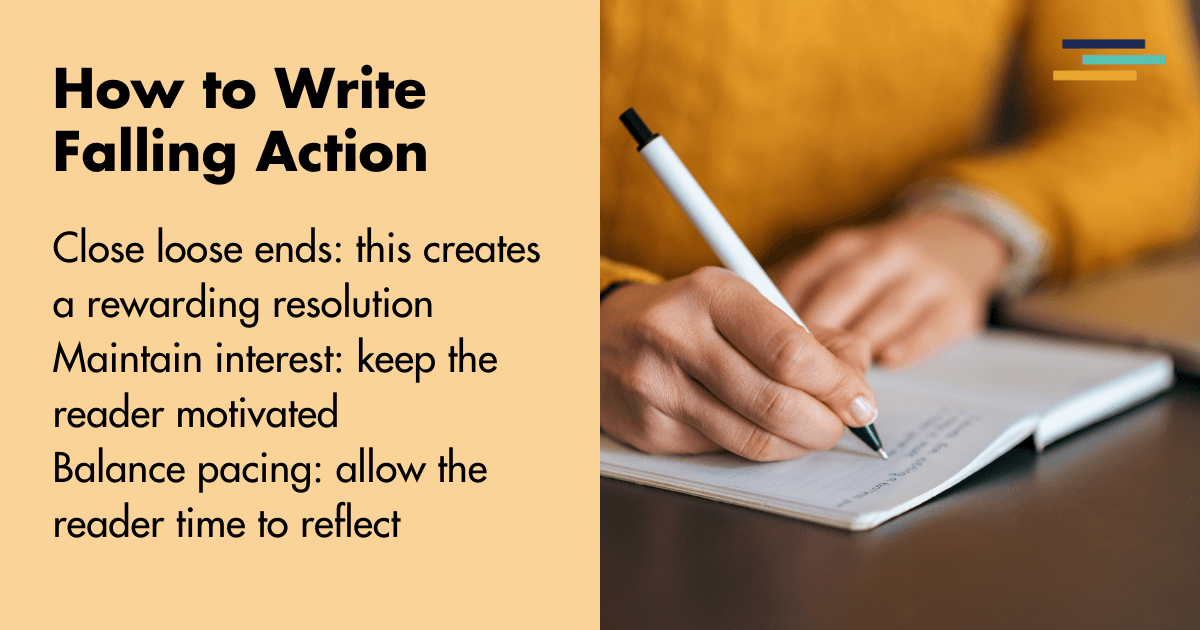
Falling action is a useful literary tool to have under your belt because it can increase the impact of the climax and create a more satisfying resolution.
To understand how falling action can improve your story, we first have to take a look at what it is and how it fits into the structure of a story.
Falling Action Definition
Falling action is the transition to the resolution but it is not the same thing as the resolution. Denouement or resolution is the final section in the story and can give the reader an idea of the future of the character.
It comes after the rising action, which is when the tension and conflict increase.
What Is Falling Action?
Falling action is that space between the pinnacle of the story that declines the tension until reaching the resolution. It is an important story element to consider utilizing in your writing as it emphasizes the main themes and gives the reader a sense of closure once they’ve reached the resolution. Without falling action, the resolution can feel rushed, incomplete, or confusing.
Falling action can also allow the protagonist to recover from the intensity of the climax. The protagonist may have endured harrowing emotions and overcome the most intense event of the story.
In the falling action sequence, the protagonist is able to breathe and begin to evaluate their own reaction and how they feel about themselves and the others in the book.
While falling action is the path leading toward the story’s resolution, it doesn’t mean that new conflicts will not arise along the way.
These sections of decreased conflict can resolve the fallout of the climax. Consider that the climax may have caused damage to the story’s settings and characters and could possibly have unleashed new conflict into the world. The protagonist would have to deal with these consequences and evaluate their effect.

What Does Falling Action Mean in the Story Arc
Gustav Freytag’s pyramid was originally developed as a framework for plays. He was a German playwright living in the 19th century who employed this pyramid-like story structure in his literary work. He placed falling action between the climax and the resolution on the right latter part of his pyramid structure.
His placement of climax is in the middle or top of the “pyramid,” making each stage appear to be the same length, creating the triangle shape. While this is a good reference for falling action, it doesn’t always apply the same way in modern plot structures.
Let’s take a quick look at a more modern story arc to see where falling action would fit in.
If we look at Fictionary’s story arc below, we can see the trajectory of the story in the line. It moves steadily up from the left starting to the inciting incident. After this, the line moves through Plot point 1, middle, and plot point 2, and increases in intensity until around 90% when the story reaches the climax. Visually, the line steadily moves higher until the highest point at the climax. It’s after this that the line visually declines, ending at the resolution.
According to what we now know about falling action, it makes sense that it would take place in the decline after the climax but before the resolution.
If you notice, the climax takes place later in Fictionary’s story arc than Freytag’s pyramid, giving a short section for falling action. The placement of the climax does have some flexibility, but it typically occurs later in modern story structures.
Falling Action Examples
Return of the King by J.R.R. Tolkien
The third book of the Lord of the Rings trilogy, The Return of the King, provides some great examples of falling action. It’s often used as an example of falling action because the ending seems to have multiple sequences to it.
There are many “miniature” events that happen after the main climax when Frodo finally reaches Morador with Sam and destroys the one ring. The destruction of the ring is the pinnacle of action for all three books, so it makes sense that the falling action extends longer than a typical novel.
The Return of the King provides a great example of the introduction of a minor conflict during falling action. There are many small adventures that Frodo and his friends have on their way back to their home in Hobbiton, but the event of Hobbiton’s invasion is a notable event in this section.
In the chapter “The Scouring of the Shire,” the hobbits discover that their home in the Shire has been overrun by “ruffians” led by Soromon in disguise. Upon their return, the hobbits have to rally for a final battle to win back their home.
The chapter ends with them continuing to pick up the pieces after reclaiming their hometown. This battle does not have the same drama or high stakes as the climax, but it shows how smaller conflicts can be introduced during falling action to keep interest after the climax. The story then continues to the final chapter, “The Grey Havens,” to resolve the series.
Peter Pan by J. M. Barrie
Another example of falling action comes from the classic children’s book, Peter Pan.
The climax of the story takes place in chapter 15 when Peter defeats Captain Hook, after which he is eaten by a crocodile.
After the climax, Wendy and her brothers return home to London on a flying ship, which begins the falling action section. Once they arrive home, Peter flies into the children’s bedroom and blocks the window. At first he won’t unblock the window but is eventually moved by the grief of the children’s mother and removes it.
Although done reluctantly, Peter shows his character development by not giving into his usual selfish actions. He sympathizes with their mother and lets go of Wendy, John, and Michael, despite wanting them to stay with him.
In the beginning of chapter 17, the fate of the lost boys is a loose end that is resolved as seen in this line:
“I hope you want to know what became of the other boys”.
After this, the lost boys are introduced to Wendy’s mother and father. Hesitant at first, they eventually agree to adopt the six lost boys who will live with them from then on. This answers any questions the reader may have concerning the lost boy’s fate after the climax.
The rest of chapter 17 is the story’s resolution. Wendy, John, Michael and the six lost boys grow up and become part of society. Peter remains forever a child but the story ends explaining that he comes every spring to take Wendy, then her daughter Jane, and so on and so forth for generations to Neverland.
Macbeth by William Shakespeare
Macbeth offers an example of falling action through the traditional play format that is closer to Freytag’s pyramid.
The climax takes place earlier in the play at the end of act II when Duncan is murdered by Macbeth to gain power. The falling action begins with a string of murders to cover Macbeth’s initial murder of Duncan.
The next sequence of falling action happens when rebellion is incited by Mcduff to place Duncan’s son on the throne instead of Macbeth. The last part of the play’s falling action is when Macbeth meets with the witches a second time. Eventually Macbeth faces Macduff and his army and is overtaken in the play’s resolution.
This placement of falling action, in contrast with the previous examples is earlier in the story. Most of the second half of the play is devoted to falling action. Beginning with the climactic murder of Duncan, Macbeth spends the rest of the play trying to maintain power.
The falling action consists of a sequence of events introducing smaller conflicts and tying off loose ends. The falling action in this section gradually decreases in intensity, transitioning the plot to the resolution of Macbeth’s defeat.

How to Write the Falling Action of a Story
Close Loose Ends
A story is often a combination of major and minor plot threads that are woven throughout the structure. Falling action provides the opportunity to tie off minor plot threads that lead to a satisfying resolution. Whether it is side plots or overflow effects from the main plot line after the climax, closing these off gives the reader a sense of completion.
Consider using falling action to complete side plots in your story to achieve a rewarding resolution for the reader.
Maintain Interest
After the emotional intensity and high action of the climax, the reader begins to decompress and move towards the resolution. Think about applying falling action to your story to maintain interest even if the highest point of action is over.
Falling action can keep the reader motivated by allowing time for reflection for the character. The protagonist needs the space to consider the after effects of the climax on their lives. This is a good time to display the result of the character development that has been taking place throughout the story.
Also, the introduction of new conflicts during the falling action may be useful to maintain interest as you move towards wrapping things up.
Balance Pacing
Falling action can be seen as a way to create balance in the overall structure of the story. While falling action doesn’t need to be the same length as every other section in the story arc, it can ease the reader into the resolution so it doesn’t feel abrupt.
Falling action can help the pacing of your story so the reader has adequate time to reflect on the story’s goals and prominent themes. The climax drives the story home, but falling action allows for a moment of rumination on the effects of the climax and what the ultimate result will be.
Falling Action Conclusion
While falling action is something that may or may not belong in your story, it can help flesh out your story structures and leave your reader with a sense of closure and satisfaction.
Whether you are using it to close off side story lines, show character development, or balance pacing, falling action is a useful literary tool to have at your disposal. Enjoy experimenting with falling action in your next project!


